I love when story drives story. Fictional books within books (or movies, or TV shows) are deliciously meta, giving us an opportunity to reflect on and admire the power of the written word and acknowledging how text can impact us.
The trope pops up in any number of great stories and in every medium…and often, fictional texts within larger stories have dark implications, or hold hidden dangers, or reveal disturbing truths about the worlds in which they exist.
I’ve compiled, for your reading and viewing pleasure, a list of five fictional texts that appear within other stories—books that can bestow formidable powers, grim truths, or valuable knowledge, and which may exact a grim cost. Some are helpful and dangerous in equal measure, and some are potential weapons, laden with nefarious purpose…
The Enchiridion (Adventure Time)
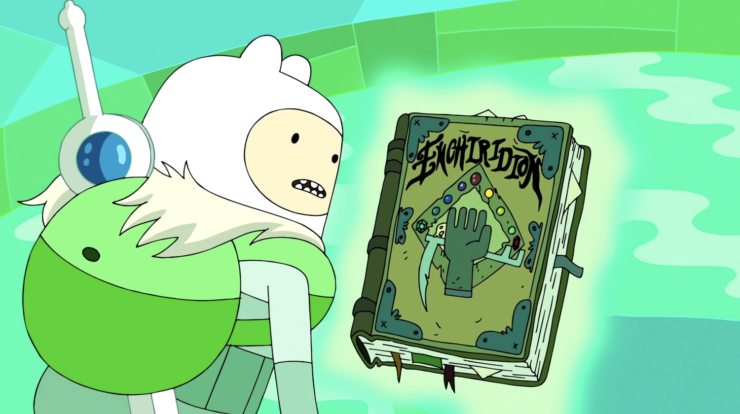
The Enchiridion is steeped in Adventure Time lore; Pendleton Ward’s wacky cartoon brings the tome back into play at various points throughout the series, though its first appearance—as a treasure to be won by Finn and Jake, who know little of its vast powers—is one of my favorites. Aptly titled “The Enchiridion!”, the episodes follows Finn and Jake as they overcome trials to recover the fabled volume, which is rumored to contain all sorts of tips on how to be a hero, such as “How To Kiss A Princess”—Finn discovers that particular tip in the episode’s final moments.
After a few stray cameos, the Enchiridion memorably rears its ugly head again in “The Lich,” bringing the book’s dark potential to the fore in a multiverse-spanning cliffhanger ending that bleeds into season five’s first episodes.
The Enchiridion is enticing because of its duality. It contains secrets, knowledge, and powers beyond the imagination of mere mortals. Every “good” deed or outcome it can accomplish might result in an unexpectedly risky or nefarious consequence. Beneath all its whimsical parody and pastiche, Adventure Time likes to grapple with concepts like the true cost of power, and the Enchiridion is a prime example.
The Crawling King
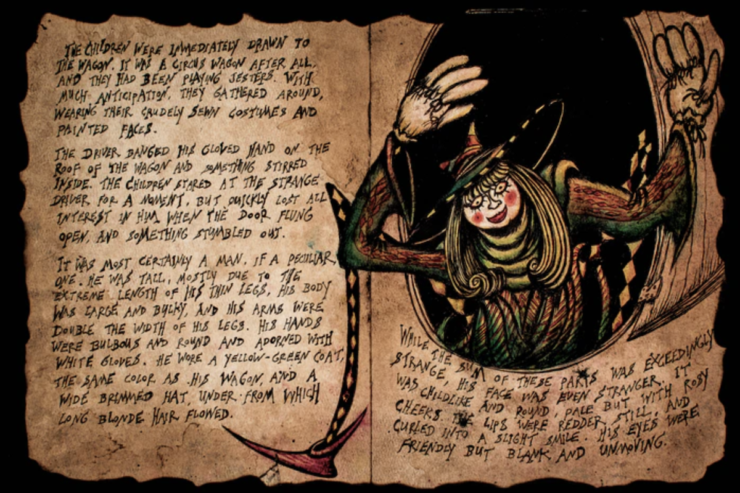
I’m guessing you’ve never heard of The Crawling King. It’s a shame, but it’s also not your fault. Artist/animator Einar Baldvin’s book of horrific stories and illustrations was funded on Kickstarter to the tune of $100,000 and released in 2018, but has since faded into obscurity after this initial run.
I was one of the lucky few who obtained a copy, and I firmly believe it deserves more attention, if you can find or borrow a copy.
The Crawling King collects burnt and ravaged handwritten documents chronicling the downfall of Gildenbrae. The once-prosperous kingdom was overrun by terrifying monsters and evil beings. Gildenbrae descended into madness and chaos, ruled by the whims of evildoers and toothy monsters.
As a graphic novel, The Crawling King visually and artistically immerses readers into the fallen Gildenbrae. Each story appears in scratchy, rushed handwriting, as though the documents were a writer’s last effort to warn survivors of the horrors overtaking the kingdom. There’s a sense of urgency to the documents punctuated by the gut-wrenching illustrations depicting the creatures that now rule Gildenbrae.
Taken as a collection of cautionary tales, the stories within The Crawling King capture the darkest moments of a formerly flourishing kingdom, leaving the reader filled with dread…but compelled to keep turning the pages.
The Death Note (Death Note anime)
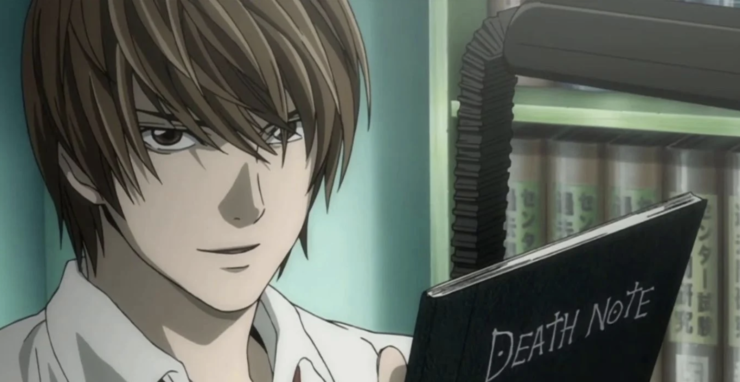
The pen is mightier than the sword in Death Note, making for delightfully macabre animations as we witness Light Yagami writing his victims’ names in the dastardly tome.
The Death Note drives the anime’s plot, giving Light the power to kill any person simply by writing their name in the book while picturing his victim’s face. The notebook itself looks fairly mundane, though it harbors devastating potential within its pages. It’s the one volume on this list that’s more dangerous for what it can contain than what it already does contain. And what does it contain, exactly? A long list of gruesome and weirdly specific rules about how it functions, forming an encyclopedic instruction booklet for would-be killers.
Should a Death Note fall into the wrong hands (and I assure you, this happens often in the show), the consequences are dire. Further, Death Note couches its narrative in an ironic mystery. We, the audience, know full well what the notebook can do, but the investigators tasked with tracking Light down do not. This makes for many a juicy storytelling moment, propelling viewers from one episode to the next.
The Way of Kings (The Stormlight Archive)
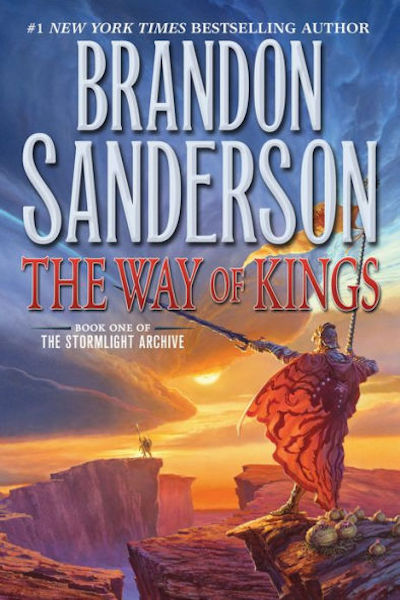
Read Brandon Sanderson’s epic fantasy novel The Way of Kings, and you might find Dalinar’s quest to follow the teachings of the titular book rather admirable. He wants to be a respected and kind leader, so he’s reading the fictional text known as The Way of Kings at the behest of his late brother, King Gavilar.
Read on in The Stormlight Archive, and you realize that every character is playing a desperate game of political chess, each controlling a handful of pieces and endlessly vying for the upper hand. Gavilar’s request that Dalinar to abide by the ancient tome looks much less altruistic the more we learn about the complicated history of the book (not to mention Gavilar’s own complex motivations).
Sure, forty parables for living a good life as adopted by the former Knights Radiant might seem like a harmless read. Combined with the ever-unraveling truths and visions that contextualize those lessons, however, The Way of Kings doesn’t seem nearly so straightforward.
Of all the fictional books on this list, I think The Way of Kings poses the least direct danger, in the grand scheme of things. But the motives and machinations that lead Dalinar to embrace it and the secrets it contains provide some of the series’ darker mysteries and revelations as the epic story continues to unfold. And of course, we’re still discovering secrets galore in The Stormlight Archive, and learning more about the history that gave rise to The Way of Kings and the events that caused it to fall so far out of favor.
The Books of Beginning
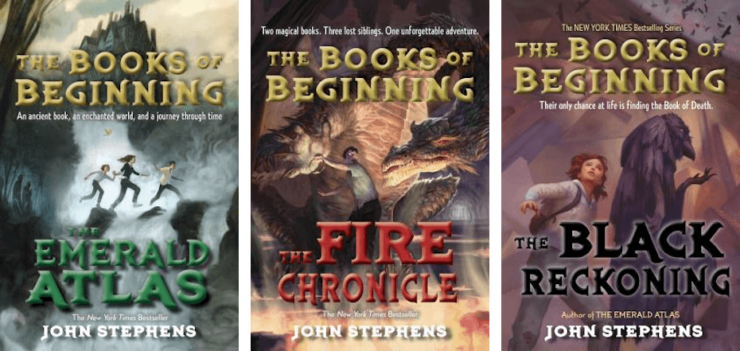
John Stephens’ Books of Beginning trilogy pits three siblings against a topsy-turvy, time-twisted world and a generation-spanning supervillain. At their disposal throughout the series are three books: The Emerald Atlas, The Fire Chronicle, and The Black Reckoning (these are also the titles of each book in the series).
The Books of Beginning series presents Kate, Michael, and Emma Wibberly with an array of challenges and mysteries, leaving them to discover the powers of their destined tomes as the Dire Magnus seeks to stop them. It’s a series geared toward young adults, but adult readers will also appreciate its twisting plot, which is packed with strong themes and characters.
Each of the fictional books has a unique and useful power. The Emerald Atlas, Kate’s book, allows her to place pictures on the pages and travel to the point in time when they were taken. Eventually, Kate gets stuck in a previous decade without any way to return, trapping her in a terrifying and unfamiliar era. These books grant power, but those powers can and do go awry.
The Fire Chronicle and The Black Reckoning each come with unique powers of their own, which I won’t spoil here as they appear in the two sequels.
I remember gobbling up this series as a teenager, yearning for the next as soon as I’d finished The Emerald Atlas. Stephens constructs a series that places real power in books, which resonated with me as an avid young reader—but he also applies dark twists and consequences to those powers, turning the stakes up to eleven as the trilogy unfolds
***
What’d I miss?! I’m sure there are many, many great examples to discuss, so please share your own favorite fictional tomes in the comments below.
Cole Rush writes words. A lot of them. For the most part, you can find those words at The Quill To Live or on Twitter @ColeRush1. He voraciously reads epic fantasy and science-fiction, seeking out stories of gargantuan proportions and devouring them with a bookwormish fervor. His favorite books are: The Divine Cities Series by Robert Jackson Bennett, The Long Way To A Small, Angry Planet by Becky Chambers, and The House in the Cerulean Sea by TJ Klune.










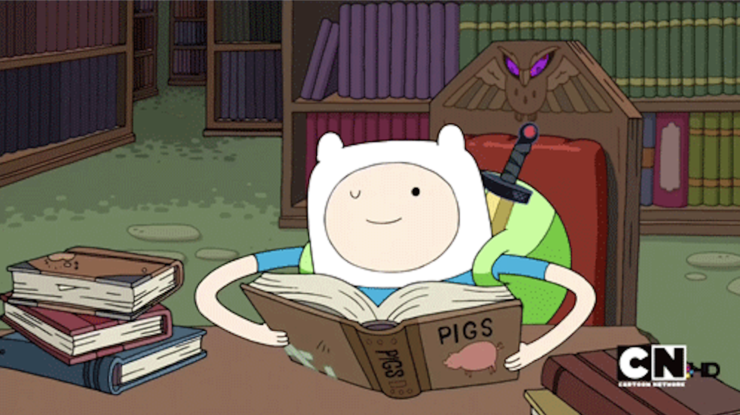
I love you Cole for mentioning The Crawling King!
We’re kickstarter pals! I’m another one of the lucky few that has the book. And if Einar Baldvin is reading this, do another kickstart, republish this, its wonderful and definitely deserves to be better known.
Since you’ve opened the door for anime here, I have to bring up an anime/manga favorite of mine: Natsume Yuujinchou, or Natsume’s Book of Friends. In it, teenager Natsume Takashi inherits both his grandmother’s ability to see and interact with spirits and her notebook of autographs. The autographs are the name of spirits and kami who can be summoned and commanded with their name; what to do with this book and competition for its ownership drive the entire story. Young Takashi’s clear decision is bold and wonderful to watch play out.
Books 1, 2 and 3 in Gravity Falls.
The Covenant of Primus, purporting to be the history of Cybertron and/or the universe –though not necessarily a record of the history (see its companion artifact, the Quill, which can rewrite that history).
Notably, each chapter is written in the common language of the time it applies to; the earliest chapters are written in languages long dead and forgotten, and the last pages are written in tongues not yet invented.
The Necronomicon, also referred to as the Book of the Dead, was created by HP Lovecraft. It has become so real that there is now one in existence written by either fans or people who believe in dark stuff. Most don’t even know its origin.
Terry Brooks’ Illdatch? Diane Duane’s “So You Want to be a Wizard”?
Not to mention I’m fairly sure my own copy of “The Illuminatus Trilogy” is a portal for eldritch forces from beyond time.
I would add the grand-daddy of them all, The King In Yellow. It was meta before that was even a thing, and Chambers’ work has influenced so many authors over the years (I know . . . Bierce influenced Chambers, but i digress). Lovecraft even brought elements into his mythos in “The Whisperer in Darkness” (Lake of Hali and the Yellow Sign).
@5: Strangely enough, I first learned about the Necronomicon from an episode of The Real Ghostbusters as a kid (“The Collect Call of Cathulhu”). I immediately went to my local library and borrowed the only book of Lovecraft they had, which contained “The Call of Cthulhu” among others. 35 years later, I’m waaaaaaaaaaaay down that rabbit hole, still devouring cosmic horror and weird fiction.
On a separate note, for anyone out there that wants to dive into stories with similar “forbidden tomes,” the “Lovecraft Circle” of his friends (like Robert E Howard, Frank Belknap Long, August Derleth, Clark Ashton Smith . . . and later additions like Robert Bloch) all contributed deities, monsters, and tomes to the pantheon. Just like the Necronomicon, some of them have popped up in other sources over the years (e.g. De Vermis Mysteriis/Mysteries of the Worm, Liber Ivonis/Book of Eibon, Unaussprechlichen Kulten/Unspeakable Cults, etc.). Other authors over the years have contributed some, with varying success, but Lovecraft and his circle set the foundation.
the Book Bound in Pale Leather, from P. C. Hodgell’s tales of the Kencyr (Godstalk ff).
@5 Re the “real” Necronomicon, you may be thinking of this, which is generally regarded in the occult community as a hoax:
https://en.wikipedia.org/wiki/Simon_Necronomicon
“The-book-that-must-be-read-to-Young-Vimes-every-evening-at-bed-time: “Where is my cow?” A book so powerful that it gives Sam Vimes the ability to even overcome the Summoning Dark in “Thud” from Terry Pratchett. Plus, the fictional “book within a book” was then published as a real book – can’t get any more meta really.
@7 The cartoon, THE REAL GHOSTBUSTERS, was awesome. My personal favorite was the man who sold his soul to a demon to make all the chickens disappear. The demon paid the crew to make him change his mind because the other demons were making fun of him.
@9. Of course, it’s a hoax in the sense that it isn’t the book Lovecraft mentioned, but the version currently circulating is known for its bad juju in the paranormal community. Belief, good or bad, is a powerful thing.
There used to be an amazingly comprehensive collection of fictitious book titles on Wikipedia. I linked to it once on a comment thread on this site. It’s since disappeared, to my chagrin.
I’m surprised that no one has mentioned the Darkhold, given its recent appearances in the MCU. I for one, however, much prefer the version in Agents of SHIELD, where any layman could read the book and find something in its pages to accomplish their goals (in a Monkey’s Paw kind of way). Scientists learned how to create “perpetual energy” (spoiler: doesn’t work that way), while an android learned how to learn humanity and a thug simply found that following his current path would allow him to succeed. Also, I loved the cover design that allowed it to read “darkhold” when held up or down.
I even have a copy of the Necronomicon. A book that lept from the pages of Lovecraft into Photocopied Filios. Cannot skip on that.
The Fillory and Further series from The Magicians comes to mind.
Hamster Huey and the Gooey Kablooie from Calvin and Hobbes
Well, this is right up my alley! I’ve got a whole Tumblr where I post and classify fictional books. Some other good examples are the Necronomicon Ex-Mortis from the Evil Dead series, the Nice and Accurate Prophecies of Agnes Nutter from Good Omens, The Babadook from the self-titled movie, the Slayer handbook from Buffy the Vampire Slayer, the three journals from Gravity Falls, and the Black Book of the Dead from the Mummy series.
And then there is Ashmole 782 from Discovery of Witches. It’s sort of real but missing and probably not made from the skins of daemons, witches and vampires.
@3 – I came here to mention these and am very pleasantly surprised that someone beat me to it :D god, that show is so good.
I’d also add the letters and notebooks left for the protagonist of The Rook by Daniel O’Malley by her former self. The more she reads, the more deeply she gets drawn into the world of the Checquy, where at least one person definitely wants to kill her.
The Book of Three from Alexander’s Prydain Chronicles comes to mind.
The Books of Beginning are so underrated! I never hear anyone talk about them, but they were great — I remember there was a ton of marketing for the first one when it came out, but nothing for the sequels, which were even better.
Modesitt, in “The Parafaith War” quotes from The Ecotech Dialogs” & “Notes from the Colloquy”. Probably worth tracking down a copy of each. The excerpts are fascinating.
The book Bastian reads in The Neverending Story was probably my first exposure to a story-within-a-story and the one that sticks with me the best.
The Riddlemaster of Hed trilogy (now rereading) references many in-universe songs (Hover and Dove) and other in-universe fictional works.
I was always fascinated by The Theory and Practice of Oligarchical Collectivism in Orwell’s Nineteen Eighty Four. As a kid I thought it was such a bold move to include dozens of pages of this fictional tome in the middle of his novel. But honestly, I’d read the whole thing if I could; it’s a brilliant example of world building.
And the children’s book Over the Woodward Wall from Seannan McGuire’s Middlegame, which she went on to publish under the fictional author’s name.
I’d like to give a shout-out to The Book of Kindly Deaths by Eldritch Black. It’s an excellently creepy little book of interconnected short stories found by the main character in the titular book. Well worth it if you haven’t read it.
Dick’s “The Man in the High Castle,” The Grasshopper Lies Heavy is the fictional book. I won’t go into details because it would involve major spoilers, but it’s about as meta as you can get. Not sure if it qualifies as dark or mysterious, but still worth mentioning.
Serial Experiments Lain for the most mysterious and darkest anime in existence!
The Architecht’s Will in Keys to the Kingdom is technically a text, though it was broken into seven pieces and scattered across the multiverse in the shapes of an array of annoying talking creatures who eventually find someone to bring them together and prove to have a very nefarious purpose indeed.